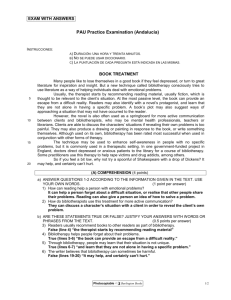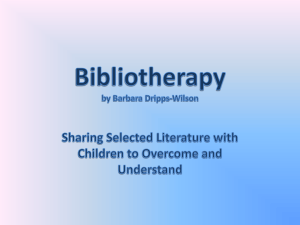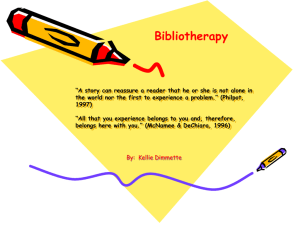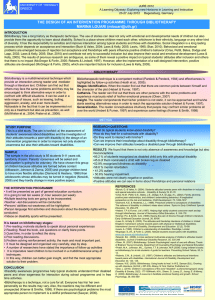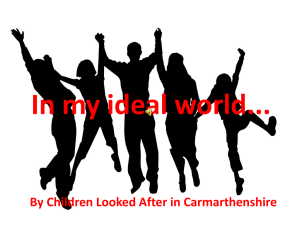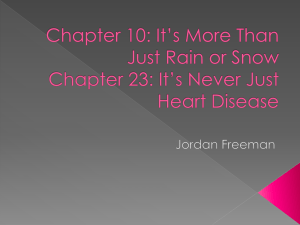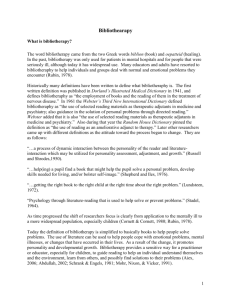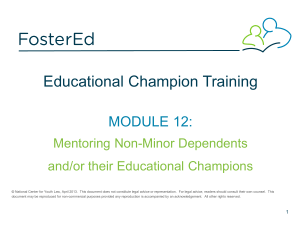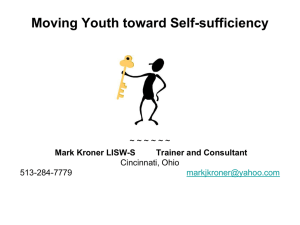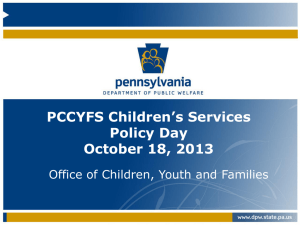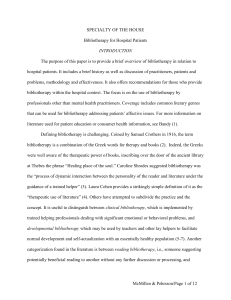File - TODD HARRIS FRIES
advertisement
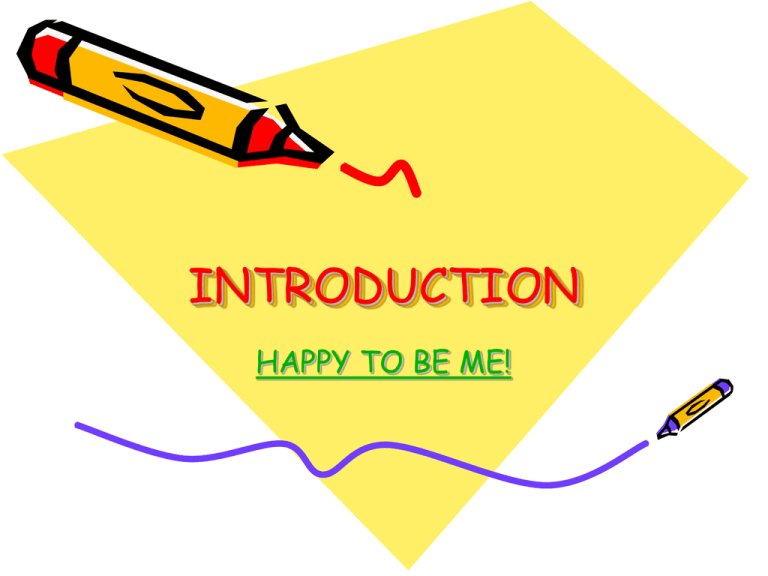
INTRODUCTION HAPPY TO BE ME! WHAT IS “HAPPY TO BE ME” ALL ABOUT? • It’s about telling a story… – It is told from a particular point of view – It is filled with precise detail – It uses plot, including setting and characters; a climax; and an ending – It uses dialogue to bring characters to life – It uses conflict and sequence as does any story – It shows how the character(s) resolves the conflict and what happens next – It leaves the reader with strong emotion and an important lesson THE FIVE ELEMENTS OF A STORY 1) Introduction 2) Rising action 3) Climax 4) Falling action 5) Resolution WHY DO WE READ STORIES TO OUR CHILDREN? Because it is something children can understand! SOMETHING A CHILD CAN UNDERSTAND Bibliotherapy and its Potential Applications in the Foster Care Environment A project developed by Todd Fries, Dan Velton & Eric Despotes WHAT IS BIBLIOTHERAPY? • Bibliotherapy Literally involves treatment through books - Pardeck & Pardeck, 1998 • Guided reading of written materials to help the reader grow in self awareness - Harris & Hodges, 1995 • Process of dynamic interaction between the personality of the reader and literature under the guidance of a trained helper - Shrodes, 1950 WHAT ARE THE BENFITS OF BIBLIOTHERAPY? • Increases awareness of and empathetic understanding for other cultures, lifestyles & lived experiences • Provides a Mirror: increases appreciation of, pride in & identification with one’s own identity, culture, ethnitcity • Promotes coping skills with life’s challenges and relieve emotional or mental pressure • Provides information and alternatives solutions to a problem • Stimulates discussion of feelings and ideas • Increases enjoyment of literature and reading TYPES OF BIBLIOTHERAPY 1) Developmental: The use of literature and facilitative processes by skilled helpers to assist individuals in dealing with life transitional and normal developmental issues 2) Clinical: The use of literature and facilitative processes by skilled mental health or medical clinicians in meeting a deliberate therapeutic goal for the purpose of assisting individuals in dealing with severe disorders and traumatic life experiences ROOTS OF BIBLIOTHERAPY • Bibliotherapy can be traced as far back as the ancient days of Greece, when libraries were first formed. • Although “bibliotherapy” has been around for centuries, it may have been referred to by different terms depending on the time period, such as: – – – – – – – Bilbio-counseling Biblio-guidance Biblio-psychology Book matching Literatherapy Library Therapeutics Literapeutics Reading Therapy ROOTS OF BIBLIOTHERAPY • In the early part of the nineteenth century, scholarly articles began to appear that promoted the use of reading as a therapeutic measure; specifically, reading was viewed as one of the best ways to treat mental patients • By the mid-nineteenth century, every major mental institution in the country had a “patient’s library” with carefully selected books, for use by the patients • Although the concept and knowledge of bibliotherapy has been known since ancient times, it wasn’t until 1916 that bibliotherapy was given the specific term to imply the use of books as a therapeutic means to help people • In addition, bibliotherapy was not applied to children until almost half a century later in 1946 • • • • • • • • HOW CAN BIBLIOTHERAPY HELP CHILDREN? Adoption and foster care Bullying Death and dying Disabilities and handicaps Divorce, separation and step-families Alcoholism and abuse Nutrition and healthy eating Anger management WHO SHOULD CONDUCT BIBLIOTHERAPY? • • • • • Mental health professionals Teachers Librarians Social workers Parents CAUTION: Bibliotherapy must be handled with great delicacy, and not every practitioner possesses the personal qualifications to be a facilitator in the process. Those who are interested, however, should possess personal stability; a genuine interest in working with others; and the ability to empathize with others without moralizing, threatening, or commanding WHO SHOULD CONDUCT BIBLIOTHERAPY? • Although traditional bibliotherapy may be carried out by a therapist, using fiction to help children isn't limited to that setting • As children read fiction and observe the behavior of the characters, they learn how to solve problems or at least that problems can be solved • A parent, a teacher, a librarian or a counselor who knows a particular child need not shy away from finding an appropriate fiction book for that child • Reserving bibliotherapy to specialists means foregoing a valuable tool to help kids with resources available to all of us • NOTE: Bibliotherapy is an adjunct, NOT a substitute, for therapy HOW DOES BIBLIOTHERAPY WORK? All models expand from initial Psychodynamic Model developed by Carolyn Shrodes (1949) Four stages or steps: 1. 2. 3. 4. Identification (projection) Catharsis (abreaction) Insight (self-awareness) Universalization THE FOUR STAGES AS APPLIED TO CHILDREN • Identification - the youngster identifies with a book character and events in the story, either real or fictitious. Sometimes it is best to have a character of similar age to the youngster who faces similar events. At other times, cartoon characters and stories are best • Catharsis - the youngster becomes emotionally involved in the story and is able to release pent-up emotions under safe conditions (often through discussion or art work) • Insight - the youngster, after catharsis (with the help of the teacher/parent), becomes aware that his/her problems might also be addressed or solved. Possible solutions to the book character's and one's own personal problems are identified • Universalization – the youngster understands that their problems are not theirs alone and realize that they are not isolated in either circumstances or feelings HOW SHOULD BIBLIOTHERAPY BE CONDUCTED? The basic procedures in conducting bibliotherapy are: (1) motivate the individual or individuals with introductory activities; (2) provide time for reading the material; (3) allow incubation time; (4) provide follow-up discussion time, using questions that will lead persons from literal recall of information through interpretation, application, analysis, synthesis, and evaluation of that information; and (5) conduct evaluation and direct the individual or individuals toward closure--this involves both evaluation by the practitioner and self-evaluation by the individual WHEN CONDUCTING BIBLIOTHERAPY, FACILITATORS SHOULD… 1. PRE-READ THE BOOK Pre-reading to decide which text and/or illustrations to emphasize, or edit out, helps maximize focus on what is causing the child concern. 2. INTRODUCE WHY YOU ARE READING TO THE CHILD Use a simple opening script to avoid getting tongue tied. For example, explain “We are reading this book because (..you’re being placed in a foster home with a new family..) and, you may have some questions, or feelings, about this. This book can help us sort these out.” 3. MAXIMIZE SUCESSUL LISTENING AND TALKING Read in a quiet, calm and uninterrupted environment to avoid having to strain when you talk to or listen to the child. TVs, computers and music systems should be turned off. 4. OPEN & GUIDE DISCUSSSION BY OPEN ENDED QUESTIONS Avoid asking questions that can be answered by only ‘yes’ or ‘no’ and instead use ‘open ended questions’ to better understand the child’s thoughts, concerns and feelings. 5. BALANCE HEAVY AND LIGHT Reading therapeutic books can be a difficult and ‘heavy’ experience for the child, so help them transition back into their routine life by a ‘light’. For example, saying: “OK, before we end today’s reading let’s both share one thing we’ve seen this week that was funny.” “TAKE A LOOK, IT’S IN A BOOK!” A NEW HOME FOR FINALOO ILLUSTRATED BY TODD FRIES WRITTEN BY TODD FRIES, DAN VELTON & ERIC DESPOTES FINALOO – A BRIEF DISCUSSION • • • • What problem(s) does this book address? What was the overall mood of the book? How did the book make you feel? What metaphors were used in the book? – – – – Who does Bobby represent? Who does Finaloo represent? Who does Bobby’s mother represent? What does the second hand store represent? • Did anyone notice the play on words w/ “second hand” store? – Who does Thomas represent? FINALOO - A BRIEF DISCUSSION • Who does Bobby represent? FINALOO - A BRIEF DISCUSSION • Who does Finaloo represent? FINALOO - A BRIEF DISCUSSION • Who does Bobby’s mother represent? FINALOO - A BRIEF DISCUSSION • What does the secondhand store represent? FINALOO - A BRIEF DISCUSSION • Who does Thomas represent? WHY USE BIBLIOTHERAPY IN FOSTER CARE? • Reading stories such as “A New Home for Finaloo” can provide a much needed sense of community for foster parents and children and can be used more purposefully as a starting point for discussion between case workers and foster parents, between case workers and foster children and between foster parents and their children • The millions of children in foster care benefit from the opportunity to learn about themselves through the characters and to learn about ways of relating to others • It provides an indirect and non threatening way to explore their fears, hopes and dreams • It helps children feel less alone and isolated and understand that children come in all shapes and sizes with different feelings even in the system • Helps foster parents to understand the children's behaviors from their perspective • Caseworkers can refresh their understandings the inner workings, thoughts, feelings, frustrations, hopes and dreams of children in the system COMMON THEMES USED IN FOSTER CARE BOOKS • Fear of Developing Attachments • Children may behave badly in attempts to do right thing • Internal conflict over betraying birth family • Siblings in foster families play an important role in supporting child's growth • Importance and difficulty of acknowledging the humanity of birth parents • Frustrations, inconsistencies and barriers created by the child welfare system (only through the foster care system do adults share children with total strangers that they may be afraid of) FOSTER CARE FACTS NATIONALLY • Across America, more than 500,000 children are in the foster care system, a number that represents a 90 percent increase since 1987 • Within 12-18 months after leaving foster case, 27 percent of males and 10 percent of females had been incarcerated; 33 percent were receiving public assistance; 37 percent had not finished high school; and 50 percent were unemployed • Children in the foster care system were found to be three to six times more likely than children not in care to have emotional, behavioral and developmental problems such as behavioral disorders, depression, and difficulties forming social relationships FOSTER CARE FACTS CALIFORNIA • In California alone, there are more than 100,000 foster children • Of those who leave foster care, 65 percent do so without a place to live, and as many as half become homeless within the first 18 months of emancipation • Youth in foster care are 44 percent less likely to graduate from high school and between 40 and 50 percent never receive a high school degree, even after emancipation FOSTER CARE FACTS LOCALLY • In Santa Clara County, nearly 3,000 children required some sort of out-of-home care in 2009, according to county statistics and more than 1,200 of these children required foster care • According to the county, 47 percent of Santa Clara County’s foster children are Latino, 31 percent are white, 16 percent are African American, and 5 percent are Asian/Pacific Islander • Therefore, it is important in efforts such as bibliotherapy not only to acknowledge a child’s age when reading or choosing literature, but also to acknowledge his or her culture and linguistic abilities OUR REASON FOR DOING THIS PROJECT • Bibliotherapy is one of the easiest, cost-effective and most efficient methods to help these children confront the emotional problems they face, and it could ultimately improve their emotional maturity and well-being as adults, something that can help them beat the statistics EFFECTIVE FOSTER CARE BIBLIOTHERAPY BOOKS INCLUDE… – Vibrant color pictures and appealing illustrations – Interesting story content and believable characters – Information within the child’s understanding – Broad humor which is fairly obvious for a young child – Surprise elements to create suspense and sustain interest – Appealing, recurring refrains, which contribute familiarity and delight the child DIFFERENT VERSIONS OF “FINALOO” FOR DIFFERENT SETTINGS Version 1: Color storybook w/ puppet – English and Spanish Version 2: Coloring book – English and Spanish Version 3: Draw-it-yourself coloring book – English and Spanish Version 4: CD-Rom with coloring book and draw-it-yourself formats COLOR STORYBOOK WITH PUPPET • Colored-in illustrations • Sock puppet: “Finaloo” to be used for acting out the story • Good for bibliotherapy right “out of the package” COLORING BOOK • Black and white picture outlines • Good for engaging activity with child (coloring) to get the child emotionally involved with the characters DRAW-IT YOURSELF COLORING BOOK • Text-only • Space set aside for child to complete • Good for fostering creativity through image design and coloring • Also serves to get the child emotionally connected with the story CD-Rom • Multiple versions of “Finaloo”: coloring book and draw-it-yourself • Available in English and Spanish • Microsoft Word format • Provides opportunity to edit own book and re-imagine the story • • • • • • • • • WHERE WILL“FINALOO” BE DISTRIBUTED? Foster homes Group homes Adoption agencies Libraries Schools Planned Parenthood Family courts Dependency courts Delinquency courts FINAL THOUGHTS • Inspire parents to create their own bibliotherapy tools • Help children in the foster system adjust to their new environments • Encourage kids to read! A library is a hospital for the mind. -Anonymous
